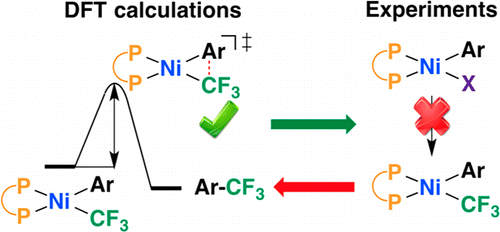A computational screening of 42 bidentate phosphines (PP) has yielded promising candidates for Ph–CF3 reductive elimination from Ni(II) complexes of the type [(PP)Ni(Ph)(CF3)]. The computed barriers and synthetic accessibility considerations have identified two PP ligands, dippf and dcypf (ΔG⧧ = 22.6 and 23.2 kcal/mol, respectively), for experimental studies with 1-Np (1-naphthyl) in place of Ph. Ligand exchange of [(Ph3P)2Ni(1-Np)Cl] with dippf or dcypf has cleanly produced [(dippf)Ni(1-Np)Cl] and [(dcypf)Ni(1-Np)Cl], the first examples of trans square-planar 1,1′-ferrocenediyl backbone-based diphosphine metal complexes devoid of M···Fe dative interactions. Treatment of these chlorides with CF3SiMe3/F–, AgCF3/MeCN or [(Ph3P)3Cu(CF3)] does not furnish isolable or 19F NMR-detectable [(PP)Ni(1-Np)(CF3)] (PP = dippf, dcypf). Other transformations have been observed instead, e.g., ligand exchange with the Ag and Cu complexes, the latter leading to [(dcypf)Cu(CF3)], a rare example of well-defined CF3Cu(I) species. With CF3SiMe3/F–, indirect evidence has been obtained for intermediacy of [(PP)Ni(1-Np)(CF3)] (PP = dippf, dcypf) and instantaneous decomposition via pathways other than C–CF3reductive elimination. The first Ni(II) complexes with fluoride trans to a non-electron-deficient aryl, [(Cy3P)2Ni(1-Np)F] and [(i-PrXantphos)Ni(1-Np)F], have been prepared and fully characterized. Surprisingly, [(Cy3P)2Ni(1-Np)F] can be produced from [(Cy3P)2Ni(1-Np)Cl] and CsF rather than AgF that is conventionally used for the synthesis of late transition metal fluorides via X/F exchange. While [(Cy3P)2Ni(1-Np)F] is unreactive toward CF3SiMe3, [(i-PrXantphos)Ni(1-Np)F] is readily trifluoromethylated to produce robust [(i-PrXantphos)Ni(1-Np)(CF3)], a rare example of complexes of the type [(PP)Ni(Ar)(CF3)] with PP other than dippe.
